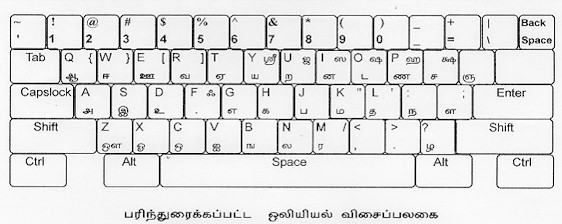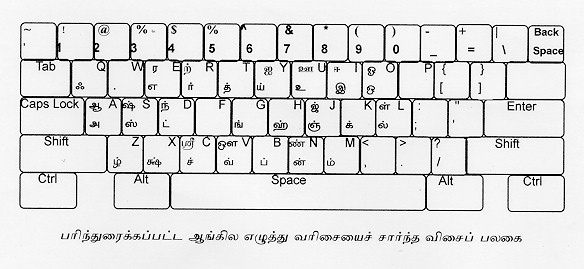|
"To us
all towns are one, all men our kin. |
| Home | Whats New | Trans State Nation | One World | Unfolding Consciousness | Comments | Search |
|
"To us
all towns are one, all men our kin. |
| Home | Whats New | Trans State Nation | One World | Unfolding Consciousness | Comments | Search |
Home > Tamil Digital Renaissance > Tamilnet'99 > Final Conference Report
It has become a necessity to link the commendable efforts in promoting Tamil into Internet carried out by the numerous Tamil enthusiasts around the world. To meet these requirements, the following decisions were taken at the International Conference - TamilNet '99, held on 7 and 8 February 1999.
Recommendations of Tamil Keyboard Standards
There have been an evolution of keyboards developed for inputting Tamil characters into a computer. Over the years a lot of improvements have been incorporated one over the other and a few excellent keyboards have been evolved. There are the three types of keyboards, for Tamil namely Romanised keyboards, Tamil Typewriter based keyboards and Phonetic keyboards, of these the Phonetic keyboards have become more popular because of its user friendliness, language specific and lesser effort involved. While standardizing the keyboards the following aspects were considered.
1. Tamil Characters frequently used should be placed in strong finger positions and less frequently used in the light finger positions.
2. The less frequently used grantha letters shall be put in locations with shift key operations.
3. The short and long vowels shall be kept in adjacent positions for a good memory and easy operations.
4. In Tamil the õ´, þ¶, ÿ» always go together and if these letters are placed adjacently it would be easy for operation and with the help of a software the additional operation for putting a dot for consonants can be avoided.
Incorporating the above aspects, a recommended standard for the phonetic keyboard is accepted. The various keyboards developed by the researchers in different parts of the world should be documented for reference.
In the interim period till switchover to Phonetic keyboard takes place the Tamil typewriter keyboard should continue without any change from the one proposed by the keyboard committee constituted by the Govt. of Tamilnadu during 1997 .
The Romanised keyboard for Tamil as proposed by the keyboard committee is suggested for limited use by those who prefer English character for typing Tamil Text
2. To implement the phonetic keyboard, to get trained in the use of phonetic keyboard and to spread the use of the same in the society, necessary actions may have to be initiated.
Recommendations of Tamil Character and Glyph Encoding Schemes
Requirements of Tamil Computing can be broadly classified under three heads
1. Word Processing and Publishing.
2. Communication and Interfaces with ASCII based Software Systems.
3. Language analysis and processing, and system software based applications.
It is possible to meet the above requirements with a single character-encoding scheme if adequate space is available. That is, in an eight-bit system there are 256 locations available of which ASCII occupies the lower 128 locations leaving only less than 128 locations for Tamil characters. This space is not adequate to render all the Tamil characters. In future, if a 2 or 3 byte system like Unicode is implemented in full, the problem of space will not arise.
Under this situation, we are forced to think of more than one system of encoding. After a careful analysis of the various requirements and limitations the following encoding scheme shown in Figure 1 below.
This scheme is conveniently adaptable for both bilingual as well as monolingual applications. A character-encoding scheme with only Tamil alphabets and consonants placed in the same locations as in the figure is recommended for modification of the existing Unicode.
Realising the importance and criticality of addressing and ensuring the changeover from the existing codes presently in use, the proposed codes are recommended as draft standard. The draft standard should be made available to one and all from a website specifically created for this purpose and a timeframe of 100 days from 9th Feb. '99 should be provided to facilitate developers to exercise the use of the draft codes in various platforms and software for compatibility and adaptability. The decision on the codes to be adopted as the standard should be taken at a meeting to be held by June 1, 1999. The procedure to receive, and consolidate the experience feedback on the draft standard will be set forth by a monitoring committee comprising of experts from within and outside India.
4. The Tamilnadu Govt. should provide adequate encouragement and help to convert the existing software systems into the new encoding system
5. To exploit the opportunities to implement the future developments in computers and Internet computing using Tamil, an active research has to be initiated worldwide. For this purpose it is necessary to create a state level Tamilnet Research Centre and an International TamilNet Communication Centre.
6. We should make the rich Tamil Literatures and the Linguistic grammars available in the Internet. It is necessary to develop Computer Softwares for dictionary thesaurus, spell checking facilities, E-mail, Tamil Hand Writing Recognition, Optical Character Recognition, Tamil Voice Processing, Natural Language Processing, Palm Leaf Character Recognition etc., The Governments in countries having Tamil as a official Language, Private organisations and the Universities should encourage such efforts.
7. The International Conference on TamilNet should be organised every year.


